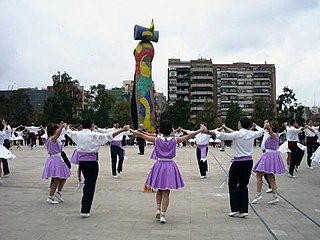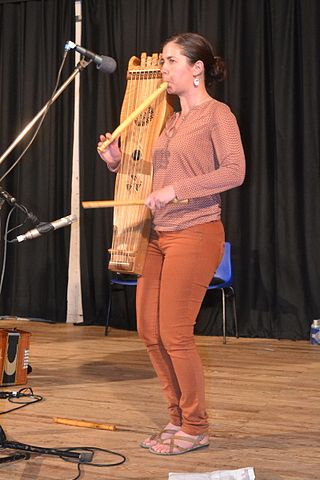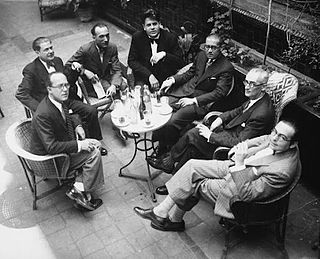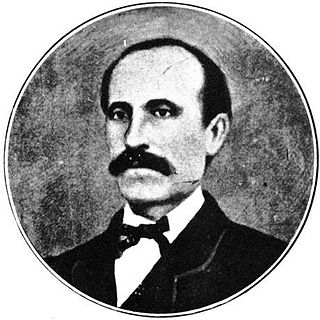
The tin whistle, also known as the penny whistle, is a simple six-holed woodwind instrument. It is a type of fipple flute, putting it in the same class as the recorder, Native American flute, and other woodwind instruments that meet such criteria. A tin whistle player is called a whistler. The tin whistle is closely associated with Irish traditional music and Celtic music. Other names for the instrument are the flageolet, English flageolet, Scottish penny whistle, tin flageolet, or Irish whistle.

In Spain, music has a long history. It has played an important role in the development of Western music, and has greatly influenced Latin American music. Spanish music is often associated with traditional styles such as flamenco and classical guitar. While these forms of music are common, there are many different traditional musical and dance styles across the regions. For example, music from the north-west regions is heavily reliant on bagpipes, the jota is widespread in the centre and north of the country, and flamenco originated in the south. Spanish music played a notable part in the early developments of western classical music, from the 15th through the early 17th century. The breadth of musical innovation can be seen in composers like Tomás Luis de Victoria, styles like the zarzuela of Spanish opera, the ballet of Manuel de Falla, and the classical guitar music of Francisco Tárrega. Nowadays, in Spain as elsewhere, the different styles of commercial popular music are dominant.

The music of Catalonia comprises one of the oldest documented musical traditions in Europe. In tandem with the rest of Western Europe, it has a long musical tradition, incorporating a number of different styles and genres over the past two thousand years.

The kaval is a chromatic end-blown oblique flute traditionally played throughout the Balkans and Anatolia. The kaval is primarily associated with mountain shepherds.

The sardana is a Catalan musical genre typical of Catalan culture and danced in circle following a set of steps. The dance was originally from the Empordà region, but started gaining popularity throughout Catalonia from the late 19th century to beginning of the 20th century after the modernisation done by Josep Maria Ventura i Casas.

A tabor, tabour, tabret, tambour de Provence, Provençal tambourin or Catalan tamborí is a portable snare drum, typically played either with one hand or with two drumsticks. The word "tabor" is an English variant of the Persian word tabīr, meaning "drum"—cf. Catalan: tambor, French: tambour, Italian: tamburo Militaries may use the tabor as a marching instrument; it can accompany parades and processions.

A pipe is a tubular wind instrument in general, or various specific wind instruments. The word is an onomatopoeia, and comes from the tone which can resemble that of a bird chirping.

Pipe and tabor is a pair of instruments played by a single player, consisting of a three-hole pipe played with one hand, and a small drum played with the other. The tabor hangs on the performer's left arm or around the neck, leaving the hands free to beat the drum with a stick in the right hand and play the pipe with thumb and first two fingers of the left hand.

The cobla is a traditional music ensemble of Catalonia, and in Northern Catalonia in France. It is generally used to accompany the sardana, a traditional Catalan folk dance, danced in a circle.

In music, a Catalan shawm is one of two varieties of shawm, an oboe-like woodwind musical instrument played in Catalonia in northeastern Spain.

The string drum or Tambourin de Béarn is a long rectangular box zither beaten with a mallet. It is paired with a one-handed flute with three finger holes, similar to a pipe and tabor. It has also been called tambourin de Gascogne, tambourin à cordes in Catalan, Pyrenean string drum, ttun-ttun in Basque, salmo in Spanish, and chicotén in Aragonese. It was known in the middle ages as the choron or chorus.

The tambori is a percussion instrument of about 10 centimetres diameter, a small shallow cylinder formed of metal or wood with a drumhead of skin. Its usual function is to accompany the playing of the flabiol in a cobla band, beating the rhythm of the sardana, the traditional dance of Catalonia.

The three-hole pipe, also commonly known as tabor pipe or galoubet, is a wind instrument designed to be played by one hand, leaving the other hand free to play a tabor drum, bell, psalterium or tambourin à cordes, bones, triangle or other percussive instrument.

The xeremia is a type of bagpipe native to the island of Majorca (Mallorca). It consists of a bag made of skin, known as a sac or sarró which retains the air, a blowpipe (bufador), a melody pipe or chanter (grall), and several, generally three, drones (bordons). The primary drone (roncó) sounds a tonic note, but the other drones are sometimes simply false drones for ornamentation.

A fiscorn is a brass instrument. It is a bass flugelhorn in the key of C. In the cobla, it has the deepest sound among the brass instruments.

Ricard Lamote de Grignon i Ribas was a Catalan Spanish composer and orchestral conductor.

Joan Lamote de Grignon i Bocquet was a Catalan Spanish pianist, composer and orchestra director.

Josep Maria Ventura i Casas, popularly known as Pep Ventura, was a Spanish musician and composer from Catalonia who consolidated the long sardana and reformed the cobla, adding instruments to give it its current formation.
Xavier Pagès i Corella is a Catalan-Spanish composer and conductor.
Vicenç Bou i Geli was a Catalan Spanish composer. He was most well known for his compositions of the traditional sardanes, which he wrote with great fluency and little sophistication, but with a gift for charming and ingenious melody.




















